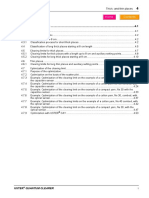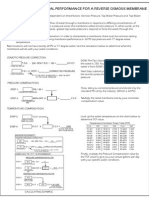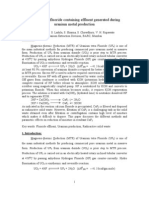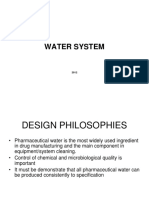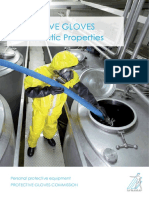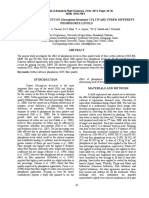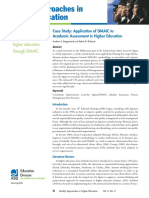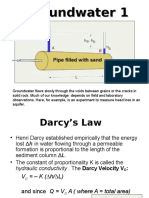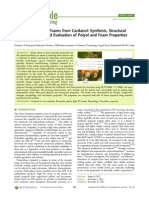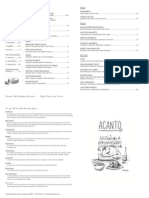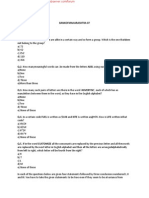Turbidity
Turbidity
Uploaded by
Amir ShahzadCopyright:
Available Formats
Turbidity
Turbidity
Uploaded by
Amir ShahzadOriginal Description:
Copyright
Available Formats
Share this document
Did you find this document useful?
Is this content inappropriate?
Copyright:
Available Formats
Turbidity
Turbidity
Uploaded by
Amir ShahzadCopyright:
Available Formats
5.
5 Turbidity
What is turbidity and why is it important?
Turbidity is a measure of water clarity how much the material suspended in water decreases the
passage of light through the water. Suspended materials include soil particles (clay, silt, and
sand), algae, plankton, microbes, and other substances. These materials are typically in the size
range of 0.004 mm (clay) to 1.0 mm (sand). Turbidity can affect the color of the water.
Higher turbidity increases water temperatures because suspended particles absorb more heat.
This, in turn, reduces the concentration of dissolved oxygen (DO) because warm water holds less
DO than cold. Higher turbidity also reduces the amount of light penetrating the water, which
reduces photosynthesis and the production of DO. Suspended materials can clog fish gills,
reducing resistance to disease in fish, lowering growth rates, and affecting egg and larval
development. As the particles settle, they can blanket the stream bottom, especially in slower
waters, and smother fish eggs and benthic macroinvertebrates. Sources of turbidity include:
Soil erosion
Waste discharge
Urban runoff
Eroding stream banks
Large numbers of bottom feeders (such as carp), which stir up bottom sediments
Excessive algal growth.
Which is the maximum allowed turbidity in drinking water?
The WHO (World Health Organization), establishes that the turbidity of drinking water shouldn't
be more than 5 NTU, and should ideally be below 1 NTU.
What are the consequences of high turbidity?
The suspended particles absorb heat from the sunlight, making turbid waters become warmer,
and so reducing the concentration of oxygen in the water (oxygen dissolves better in colder
water). Some organisms also cant survive in warmer water.
The suspended particles scatter the light, thus decreasing the photosynthetic activity of plants
and algae, which contributes to lowering the oxygen concentration even more.
As a consequence of the particles settling to the bottom, shallow lakes fill in faster, fish eggs and
insect larvae are covered and suffocated, gill structures get clogged or damaged
What are the impacts of turbidity?
The main impact is merely esthetic: nobody likes the look of dirty water. But also, it is essential to
eliminate the turbidity of water in order to effectively disinfect it for drinking purposes. This adds
some extra cost to the treatment of surface water supplies. The suspended particles also help the
attachment of heavy metals and many other toxic organic compounds and pesticides.
Read more: http://www.lenntech.com/turbidity.htm#ixzz0eXKCrmiq
You might also like
- Open End SpinningDocument8 pagesOpen End SpinningAmir Shahzad75% (4)
- SWRO Chemical CalculationsDocument38 pagesSWRO Chemical CalculationsBenjamin MillerNo ratings yet
- Technology VisionDocument289 pagesTechnology VisionPrabhat KumarNo ratings yet
- Thick, Thin PlacesDocument56 pagesThick, Thin PlacesAmir Shahzad100% (5)
- Xyz Industries LTD.: Operation & Maintenance ManualDocument49 pagesXyz Industries LTD.: Operation & Maintenance ManualamolbagadeNo ratings yet
- Turbidity & TSSDocument3 pagesTurbidity & TSSashim_ju983902No ratings yet
- By Pass RotameterDocument6 pagesBy Pass Rotameterkrishna kumarNo ratings yet
- Fluoride ToxicityDocument10 pagesFluoride ToxicityNatey AndradeNo ratings yet
- Kuliah 7 - Fuzzy Inference SystemDocument29 pagesKuliah 7 - Fuzzy Inference Systemtutur ramdaniNo ratings yet
- Calc FormulaDocument1 pageCalc FormulaVaibhav PathakNo ratings yet
- Is 13268 1992 PDFDocument19 pagesIs 13268 1992 PDFMuhammad ImranNo ratings yet
- Waste Water ReportDocument27 pagesWaste Water ReportkomalNo ratings yet
- Problems of Drinking Water in Rural AreaDocument14 pagesProblems of Drinking Water in Rural AreaRoumyadeep ChakrabortyNo ratings yet
- Permissible Limit of Drinking WaterDocument6 pagesPermissible Limit of Drinking WaterronitNo ratings yet
- Room ACis.1391.2.1992Document36 pagesRoom ACis.1391.2.1992Ajay MenonNo ratings yet
- Treatment of Fluoride Containing Effluent Generated During Uranium Metal Production - PaperDocument7 pagesTreatment of Fluoride Containing Effluent Generated During Uranium Metal Production - PaperYogesh LadolaNo ratings yet
- Reverse Osmosis System Analysis For Filmtec™ Membranes Rosa 9.1 Configdb U399339 - 282 Project: Enerau - Hydro Case: 1 NP, MFT 10/25/2018Document3 pagesReverse Osmosis System Analysis For Filmtec™ Membranes Rosa 9.1 Configdb U399339 - 282 Project: Enerau - Hydro Case: 1 NP, MFT 10/25/2018unconformistNo ratings yet
- Wastewater TreatmentDocument190 pagesWastewater Treatmentjebril yusufNo ratings yet
- Thermal Fluid Heaters 130806005318 Phpapp02 PDFDocument166 pagesThermal Fluid Heaters 130806005318 Phpapp02 PDFramakrishna.goliNo ratings yet
- Travelling Band ScreensDocument2 pagesTravelling Band ScreensIngénérie traitement des eauxNo ratings yet
- Drinking Water - SpecificationDocument24 pagesDrinking Water - SpecificationAmanjit SinghNo ratings yet
- Potassium Permanganate As Oxidant in The Cod Test For Saline Water SamplesDocument11 pagesPotassium Permanganate As Oxidant in The Cod Test For Saline Water SampleskomodobutaNo ratings yet
- Biomanipulation of Lake EcosystemsDocument5 pagesBiomanipulation of Lake Ecosystemsgheorghe danielaNo ratings yet
- Basics of Reverse Osmosis PrincipleDocument6 pagesBasics of Reverse Osmosis Principlezerocool86No ratings yet
- 250 LPH Ro PlantDocument4 pages250 LPH Ro PlantKamatchi NathanNo ratings yet
- Turbo Blower Data SheetDocument87 pagesTurbo Blower Data SheetDhamotharan Chinnadurai100% (1)
- Abu Orf M.M. Centrate Viscosity For Continuous Monitoring of Polymer Feed in Dew Ate Ring Applications 2003Document8 pagesAbu Orf M.M. Centrate Viscosity For Continuous Monitoring of Polymer Feed in Dew Ate Ring Applications 2003fermortaraNo ratings yet
- Colligative PropertiesDocument26 pagesColligative PropertiesYAWAR SAEED100% (1)
- Wastewater Treatment-1Document50 pagesWastewater Treatment-1Praba KaranNo ratings yet
- The Design and Testing of A Continuous Effluent Sterilization System For Liquid WasteDocument8 pagesThe Design and Testing of A Continuous Effluent Sterilization System For Liquid Wastepeyman mahinsaNo ratings yet
- Water Treatment Plant - Part-IIDocument30 pagesWater Treatment Plant - Part-IIPrudhvi Raj100% (1)
- Introduction To Biogas TechnologyDocument13 pagesIntroduction To Biogas TechnologyankNo ratings yet
- HydranauticsDocument17 pagesHydranauticsNafian AwaludinNo ratings yet
- Centrifugal Pump Practical ReportDocument21 pagesCentrifugal Pump Practical ReportSlindile HlambisaNo ratings yet
- Indion 8112Document2 pagesIndion 8112maksudur4100% (1)
- Chapter 16 Lime SofteningDocument10 pagesChapter 16 Lime Softeningkpranjal15No ratings yet
- Aeration System and Oxygen RequirementDocument7 pagesAeration System and Oxygen Requirementdzari6738No ratings yet
- Water Supply: Design Approach and MethodologyDocument81 pagesWater Supply: Design Approach and Methodologysagar mittalNo ratings yet
- 50 KLD Biological & Tertiary Treatment Plant - RLS FinalDocument6 pages50 KLD Biological & Tertiary Treatment Plant - RLS FinalkezaihrajNo ratings yet
- Water (2012)Document37 pagesWater (2012)antigoblokNo ratings yet
- WWTP Mardan 1st PhaseDocument41 pagesWWTP Mardan 1st Phasemohammad armaghan100% (1)
- Minor Loss Coefficients in Pipes and Tubes ComponentsDocument2 pagesMinor Loss Coefficients in Pipes and Tubes ComponentsSurendra ReddyNo ratings yet
- Electromagnetic Flow MetersDocument11 pagesElectromagnetic Flow Meterssethuraghul100% (1)
- User Manual 50 LPH Ro Skid: Ion Exchange (India) LTDDocument8 pagesUser Manual 50 LPH Ro Skid: Ion Exchange (India) LTDAnand SachanNo ratings yet
- Water2 0506Document36 pagesWater2 0506Chandra SekharNo ratings yet
- Tankfarm DesignDocument15 pagesTankfarm DesignVaibhavladNo ratings yet
- TextileDocument36 pagesTextileDr-Sheetanshu Pandey0% (1)
- Energy Optimization in Parallel or Cross Feed Multiple-Effect EvaporatorDocument12 pagesEnergy Optimization in Parallel or Cross Feed Multiple-Effect Evaporatorkishna009No ratings yet
- Reed Bed System FINALDocument12 pagesReed Bed System FINALHardik Kashyap VepariNo ratings yet
- Physio-Chemical Analysis of Water Samples Collected From Jummapatti Area, Neral, MaharashtraDocument4 pagesPhysio-Chemical Analysis of Water Samples Collected From Jummapatti Area, Neral, MaharashtraEditor IJTSRDNo ratings yet
- Low Cost Treatments PDFDocument55 pagesLow Cost Treatments PDFDrShrikant JahagirdarNo ratings yet
- Prodution of Ferrous Sulfate From SteelmakingDocument7 pagesProdution of Ferrous Sulfate From SteelmakinganaazizNo ratings yet
- Characteristics of Waste Water in Sewage Treatment Plant of Bhopal IndiaDocument6 pagesCharacteristics of Waste Water in Sewage Treatment Plant of Bhopal Indiasunaina agarwalNo ratings yet
- Aluminium ExtractionDocument5 pagesAluminium ExtractionSammyJayNo ratings yet
- Mini Project ReportDocument5 pagesMini Project ReportSaj BhaiNo ratings yet
- Water Purifier Home in DubaiDocument33 pagesWater Purifier Home in DubaiaquaproNo ratings yet
- Presentation 2Document23 pagesPresentation 2amandaNo ratings yet
- Optimization of Anaerobic Mechanism Using Response Surface Methodology (RSM) To Treat Pulp and Paper Industry Wastewater: A ReviewDocument9 pagesOptimization of Anaerobic Mechanism Using Response Surface Methodology (RSM) To Treat Pulp and Paper Industry Wastewater: A ReviewEditor IJTSRDNo ratings yet
- CH and N O Emissions From Waste Water Handling: CknowledgementsDocument14 pagesCH and N O Emissions From Waste Water Handling: CknowledgementsTaha OpedNo ratings yet
- Discussion Exp2Document2 pagesDiscussion Exp2fakhrulNo ratings yet
- Water Quality: Criteria Factors Influencing QualityDocument26 pagesWater Quality: Criteria Factors Influencing QualityncisisthebestNo ratings yet
- Turbidity Is The Cloudiness or Haziness of A Fluid Caused by Large Numbers of IndividualDocument26 pagesTurbidity Is The Cloudiness or Haziness of A Fluid Caused by Large Numbers of IndividualHaris ShaikhNo ratings yet
- 2018 Book ProceedingsOf3rdInternationalS PDFDocument945 pages2018 Book ProceedingsOf3rdInternationalS PDFAmir ShahzadNo ratings yet
- UV STANDARD 801 Brochure Textile Uv Protection ENDocument12 pagesUV STANDARD 801 Brochure Textile Uv Protection ENAmir ShahzadNo ratings yet
- 4 R Waste Management in TextileDocument7 pages4 R Waste Management in TextileAmir ShahzadNo ratings yet
- 1B ProcessingDocument13 pages1B ProcessingAmir ShahzadNo ratings yet
- Fiche Gants Electro en New Bd2Document8 pagesFiche Gants Electro en New Bd2Amir ShahzadNo ratings yet
- Fiber QualityDocument5 pagesFiber QualityAmir ShahzadNo ratings yet
- Fabric Construction Chart 1 PDFDocument1 pageFabric Construction Chart 1 PDFAmir ShahzadNo ratings yet
- Noise Pollution and Its Control in Textile IndustryDocument6 pagesNoise Pollution and Its Control in Textile IndustryAmir ShahzadNo ratings yet
- Case Study Application of Dmaic To Academic Assessment in Higher EducationDocument10 pagesCase Study Application of Dmaic To Academic Assessment in Higher EducationAmir ShahzadNo ratings yet
- Comber: The Combing ProcessDocument21 pagesComber: The Combing ProcessAmir Shahzad100% (4)
- Lecture 19w Groundwater 1 Darcy PowerpointDocument19 pagesLecture 19w Groundwater 1 Darcy PowerpointAmir ShahzadNo ratings yet
- Leadership Secrets of Prophet Muhammad SAWDocument4 pagesLeadership Secrets of Prophet Muhammad SAWAmir Shahzad100% (1)
- InVina Chile Viticultural Zone PresentationDocument41 pagesInVina Chile Viticultural Zone PresentationAlexander HuberNo ratings yet
- Guidance Display Gondola Focus Category Ed. 03 (Periode 1-15 Feb 23Document1 pageGuidance Display Gondola Focus Category Ed. 03 (Periode 1-15 Feb 23claraozzy79No ratings yet
- BambooCraftsKerala PDFDocument46 pagesBambooCraftsKerala PDFFinga Shelter Rivung100% (2)
- Gordon, Richard Juico "Dick": Bagumbayan Campaign Slogan: Pagbabago. SiguradoDocument9 pagesGordon, Richard Juico "Dick": Bagumbayan Campaign Slogan: Pagbabago. Siguradojoserizal666No ratings yet
- Itagutwa Water ProjectDocument8 pagesItagutwa Water Projectjustin titoNo ratings yet
- ACS Sustainable Chemistry and Engineering Rigid Polyurethane Foams From Cardanol Synthesis, Structural Characterization, and Evaluation of Polyol and Foam PropertiesDocument11 pagesACS Sustainable Chemistry and Engineering Rigid Polyurethane Foams From Cardanol Synthesis, Structural Characterization, and Evaluation of Polyol and Foam PropertiesCarlosNo ratings yet
- ABSTRACT RECEIVED 13thUSSTC FINALL PDFDocument82 pagesABSTRACT RECEIVED 13thUSSTC FINALL PDFAbhay Srivastava SrivastavaNo ratings yet
- Pride of CowsDocument92 pagesPride of CowsSurbhi GargNo ratings yet
- Introduction To World CivilizationDocument21 pagesIntroduction To World Civilizationtunali21321100% (2)
- Drums of YorubaDocument10 pagesDrums of Yorubajoy_adekanmi75% (4)
- Hydroponic Tomato Production in Soilless Culture - February 13, 2018 - Petrus LangenhovenDocument19 pagesHydroponic Tomato Production in Soilless Culture - February 13, 2018 - Petrus LangenhovenAhmad Abdalraheem AamerNo ratings yet
- Roads Sensitive Habitats and WildlifeDocument231 pagesRoads Sensitive Habitats and WildlifeShikhin GargNo ratings yet
- Botany ProjectDocument29 pagesBotany ProjectHarish KakraniNo ratings yet
- Strategic Analysis OF ENGRO FOODSDocument7 pagesStrategic Analysis OF ENGRO FOODSTalha MairajNo ratings yet
- Journey of The Farmers Rebellion - 2020-21Document30 pagesJourney of The Farmers Rebellion - 2020-21lalatNo ratings yet
- Acantodinnermenu8 18 14Document2 pagesAcantodinnermenu8 18 14Daniel GerzinaNo ratings yet
- NOUN CountVsNonCountDocument22 pagesNOUN CountVsNonCountBagasWicaksanaNo ratings yet
- IBPS PO Model Paper - Bank of Maharashtra Probationary Officer 2007 Solved Question PaperDocument38 pagesIBPS PO Model Paper - Bank of Maharashtra Probationary Officer 2007 Solved Question PaperMurali KhanNo ratings yet
- Chapter 1 Intoduction OverviewDocument18 pagesChapter 1 Intoduction OverviewjlysntsNo ratings yet
- Agriculture Notes Ans QaDocument30 pagesAgriculture Notes Ans QaPuja BhardwajNo ratings yet
- Eggshell in Concrete PDFDocument3 pagesEggshell in Concrete PDFGil L. Garnatcha Ill100% (1)
- Economic Life Under The SpainDocument7 pagesEconomic Life Under The SpainCheska BustosNo ratings yet
- COMPREHENSIVE Project Report: Prepared byDocument21 pagesCOMPREHENSIVE Project Report: Prepared byvtejas842No ratings yet
- RFF Cookbook RecipesDocument111 pagesRFF Cookbook Recipescomicguy680% (1)
- Carbon Dioxide SequestrationDocument10 pagesCarbon Dioxide SequestrationKevin Mandira LimantaNo ratings yet
- Thierfelder e Wall, 2009Document11 pagesThierfelder e Wall, 2009Barbara SilvaNo ratings yet
- Aexe12 PDFDocument2 pagesAexe12 PDFgrandoverallNo ratings yet
- IvatanDocument5 pagesIvatanNerinel CoronadoNo ratings yet
- Goedhuis Burgundy - 2016 - EP - BrochureDocument55 pagesGoedhuis Burgundy - 2016 - EP - BrochureJames ChoongNo ratings yet
- Fishing Boat GuidelinesDocument8 pagesFishing Boat GuidelinesToto DandoNo ratings yet



